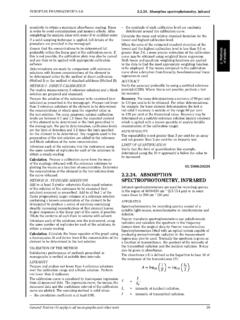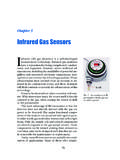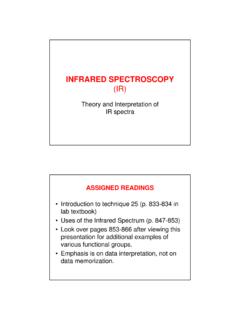Transcription of Pyroelectric Infrared Detectors
1 DIAS Infrared GmbH, 2006 Pyroelectric Infrared Detectors1. Principal set-upFigure 1 shows the principle set-up of a Pyroelectric Infrared detector. Components are theresponsive element and the preamplifier whose essential elements are integrated in thedetector. The sensitive element consists of a Pyroelectric chip which is thin and covered withelectrodes. In some cases an absorption layer is applied to the front of the responsive elementto improve its absorption behavior. top electrodebottom electrodepyroelectric materialamplifiersensitive elementd p S (t) A S u (t)R u (t)SFigure 1: Principle set-up of a Pyroelectric Infrared detectorThe incident radiation flux S(t) hits the radiation-sensitive element with the area AS andabsorption coefficient.
2 The absorption of radiation flux results in a temperature change T(t) within the Pyroelectric material. The Pyroelectric effect generates charges Q(t) on theelectrodes. These charges are transformed into a signal voltage uS (t).Various noise sources in the Pyroelectric chip and the preamplifier generate a noise voltageuR (t) at the detector output. This voltage limits the radiation flux, which can be detected inthe Detector characteristicsThe essential characteristics of Pyroelectric Detectors are the responsivity SV, the noiseequivalent power NEP and the specific detectivity D*. They are defined in the steady-statecondition for sinusoidal processes. They generally depend on modulation frequency f,wavelength and detector temperature ) ResponsivityThe responsivity SV is defined as: DIAS Infrared GmbH, 2006 SSVuS =~~[V/W](1)where: S ~rms value of the sinusoidally modulated radiation fluxSu ~rms value of the sinusoidal signal voltage at the detector ) Noise equivalent powerThe noise equivalent power NEP characterises the signal-to-noise ratio of the detector:VRSuNEP =~[W](2)where.
3 Ru ~rms value of the noise voltage at the detector combination of the equations (1) and (2) shows that the noise equivalent power representsthe minimum detectable power of the detector, and is given by a ratio of 1 between signalvoltage and noise voltage (1~/~= RSuu).c) Specific detectivityThe specific detectivity characterises also the signal-to-noise ratio:RnVSSuSANEPBAD == ~[cmHz1/2/W](3)where:BuuRRn/~~ = [V/Hz1/2](4)Rnu ~effective value of the noise voltage at the preamplifier outputnormalized on a bandwidth B = 1 definition of the specific detectivity allows a simple comparison between the D* value ofthe real sensor and the theoretical D* limit. This limit depends only on nature constants(Boltzmann constant k, Stefan-Boltzmann constant ) and the temperature T:5max16/1 TkD = (5)For a temperature of 300 K this value amounts to: maxD = 1,8.
4 1010 cmHz1/2/W . DIAS Infrared GmbH, 20063. Pyroelectric materialThe Pyroelectric material takes a fundamentally position as the real transducer element in thepyroelectric radiation detector. Of 32 existing crystal classes crystals with the point groupbalance 1, m, 2, mm2, 3, 3 m, 4, 4 mm, 6 and 6 mm have a so-called spontaneous polarizationwhich makes the appearance of the Pyroelectric effect possible. Crystals of these crystalclasses are called Pyroelectric materials. Pyroelctric materials at which the spontaneouspolarization can appear only in one single direction in the crystal (uniaxial pyroelectricmaterials) are technically meaningful. The crystal classes 2, mm2, 3, 3 m, 4, 4 mm, 6 and 6mm, are included.
5 The direction of the spontaneous polarization and the polar axis of thecrystal are the use in Pyroelectric radiation Detectors the following material characteristics of thepyroelectric material are of importance:ppyroelectric coefficient rdielectric constanttan dielectric losscP volume-specific heat capacityFor high values of responsivity SV and specific detectivity D* a big Pyroelectric coefficient pand small values of dielectric constant r, dielectric loss tan and volume-specific heatcapacity cP are many years the Pyroelectric material lithium tantalate (LiTaO3 ) has proved itself at use inpyroelectric Detectors . It fulfils not only the demands on material characteristic quantities justmentioned but also stands out due to an excellent temperature stability and very goodreproducibility of the detector material properties of LiTaO3 at room temperature are:p = 1,8.
6 10-8 Ccm-2K-1 r = 43tan = 0,001cP = 3,2 Jcm-3K-14. Equivalent electric circuits of the responsive element and preamplifierThe absorption of the radiant flux S causes a temperature change T in the pyroelectricmaterial. This temperature change T generally depends on the place in the pyroelectricmaterial. This local dependence can be often neglected in good approximation. The thermalbehavior of the responsive element can be represented in these cases by a simple analogouselectrical substitute circuit diagram (figure 2) with heat capacitySPPPAdcH =(6)where:dPthickness of the responsive elementand thermal conductance G between the sensitive element and his surroundings.
7 DIAS Infrared GmbH, 2006 Because of the statistical behaviour of the heat exchange between responsive element andsurrounding a so-called temperature noise is produced. Therefore in figure 2 an additionalnoise source is included, with:GkTpRnT24~=(7) 1j 2: Analogous electric circuit of the responsive element at simplified thermal conditionsThe temperature variation T leads to a Pyroelectric current which flows at short circuit of theelectrodes of the sensitive element. This Pyroelectric current arises under consideration of thedefinition of the Pyroelectric coefficient and the thermal conditions according to figure 2:RPPSPT dcpi = (8)withTTRjjT +=1(9)GHT/= (10)f 2=(11)The dimensionless function TR is called complex normalized current responsivity.
8 For asensitive element isolated ideally thermally (G = 0) the complex normalized currentresponsivity reaches the value 1. For most sensor constructions and for practically interestingmodulation frequencies f = Hz this value 1 is a good approximation, if the thermaltime constant T has corresponding values. If the incident radiation is not modulated (f = 0),no Pyroelectric current is produced. A Pyroelectric detector is not responsible for a constantradiation. He always needs a temporal modulation of the incident radiant flux 3 shows the electrical circuit of the responsive element. Input quantity is thepyroelectric current after equation (8). Substitute elements are the electrical capacityPSroPdAC =,(12) DIAS Infrared GmbH, 2006the frequency dependent resistance() tan/1 PPCr=(13)and the so-called tan noise source tan4~PRnDCkTi=.
9 (14)It describes thermal noise of the element resistance p c 3: Electrical circuit of the responsive elementIn figures 4 and 5 the electrical circuits of two fundamental preamplifier variants(preamplifier in voltage mode or current mode) are represented. Substitute elements are inboth cases the input resistance reV and input capacitance CeV as well as current noise andvoltage noise RnVi~ or RnVu~ of the preamplifier. The thermal noise of the input resistance isdesciped by noise source:eVRnRrkTi4~=.(15)If the preamplifier is operated in voltage mode, gain vV must be taken into account. Thepreamplifier in current mode contains a negative feedback op-amp (gain ) with resistorRGK, his capacity CGK and his thermal noise:GKRnGKRkTi4~=.
10 (16) CeViRRinoutuv 4: Electrical circuit of a preamplifier in voltage mode DIAS Infrared GmbH, 2006 CGKiRGKF igure 5: Electrical circuit of a preamplifier in current mode5. ResponsivityAccording to the defining equation (1) the responsivity SV in voltage mode is given by:()VPRPVvCRRdTcpS21 + =(17)withR = rP // reV(18)C = CP + CeV(19)The electrical time constant is given by:CRE= .(20)For many Detectors 1 RT, ( CR)2 >> 1 and CP >> CeV are valid. Then equation (17)simplifies considerably:SoVrPVAvcpS =(21)In this case, responsivity is indirectly proportional to the modulation responsivity in current mode is given by:()21 GKGKGKPRPVRCRdTcpS + =(22) DIAS Infrared GmbH, 2006If 1 RT and ( CGKRGK)2 << 1 are valid, the responsivity is independent of modulatingfrequency:PGKPVdRcpS = (23)If ( CGKRGK)2 >> 1, thenGKPPVCdcpS 1 =.






